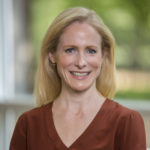By Kara Sherrer
Richard Rosenow, (MBA’16), Workforce Planning Analyst – People Analytics at Facebook, describes people analytics as a combination of HR and data science: “There’s this weird Venn diagram of those two circles, and in the center there’s a thin sliver,” he said. That thin sliver is where people analytics professionals like himself reside, combining both HR and data science in a small but growing area of work.

Sandy Kinnett
Whether they’re working in people analytics roles or simply looking to bolster their work with data, Vanderbilt Business MBA graduates in HR roles are increasingly relying on data to get the job done. “People analytics is certainly a growing area of importance,” said Sandy Kinnett, Senior Associate Director and Career Management Center Coach. “Over the last several years, there’s been an increased interest in candidates understanding and leveraging data analytics to drive their HR strategy, whether that’s in a specific people analytics role or within the broader context of other HR opportunities.”
People Analytics, Explained
Mark Shuster (MBA’08), Manager of Workforce Analytics at Gallagher, a major insurance company, has a very simple definition of people analytics: “When you have any kind of data that’s related to people or talent, and you can put that data to use, that in effect is people analytics,” he said. “It’s making the jump from HR as intuition to HR as talent analytics or quantitatively-driven decisions.”
Dan George, (MBA’14), who’s partnering to start his own people analytics firm focused on M&A activity, recalls the first major project he worked on at his former manufacturing employer. By sifting through the talent acquisition analytics, George and his team were able to prove that it was significantly cheaper to hire recruiters in house than to contract outside search firms. “(The project) was amazing,” he said. “It was clear, it was clean cut, there weren’t a lot of qualitative aspects that people could refute.”
The definition of people analytics may seem relatively straightforward, but naming the field hasn’t been. Rosenow keeps a running list of different names for the field that he’s crowdsourced from colleagues; he’s up to 40 terms now. The top four names are people analytics, workforce analytics, talent analytics, and HR analytics, but companies use many, many more: HR business intelligence, behavioral insights, colleague learning and analytics, and so on. Because of this plethora of names, starting a broad job search and then narrowing it down often pays off for those looking to launch a career in the field.
(People analytics) is making the jump from HR as intuition to HR as…quantitatively-driven decisions. -Mark Shuster
What People Analytics Offers
While many other fields — including finance, marketing, and operations — have already gone through the data revolution and solidified accepted best practices, HR is still growing in this area, meaning there’s lots of room for early adopters to help shape the field. “They’ve already gone through this, and now it’s HR’s turn,” Shuster said.
 People analytics also allows for a unique combination of qualitative and quantitative work. George realized this right after college, on the first consulting project he was ever assigned to, helping to implement an e-recruiting service at the enterprise level for a client. Hoping to put his engineering science major to use in a more technical way, George was originally disappointed at being assigned a “soft” HR project — but he soon realized that people analytics could indeed be quantitative.
People analytics also allows for a unique combination of qualitative and quantitative work. George realized this right after college, on the first consulting project he was ever assigned to, helping to implement an e-recruiting service at the enterprise level for a client. Hoping to put his engineering science major to use in a more technical way, George was originally disappointed at being assigned a “soft” HR project — but he soon realized that people analytics could indeed be quantitative.
“It uses the same kind of analytical mindset that you would use as an engineer, but we can apply it to the most interesting aspect of business, which is people,” he said. “(People) analytics are so different than regular analytics. They are a heavy mix of qualitative understanding with the quant side. If you’re not able to marry that up, it’s difficult to pull those intelligence or insights out of it.”
Launching with an MBA
The combination of qualitative and quantitative is part of what makes an MBA an excellent launching pad for a people analytics career. The MBA core curriculum covers essential subjects such as finance and accounting, which lets people analytics professionals speak the language of other decision-makers in their company. Most MBA programs also include classes in “people skills” like leadership as well as analytics courses. “An ability to understand the business and business outcomes is the first step in any of the people analytics work,” Shuster explained.
Getting a strong background in HR is also helpful, since people analytics teams often sit within HR departments. Vanderbilt Business is one of the few MBA programs to offer an HR/human capital concentration, called human and organizational performance (HOP). “I think that the HOP courses give you a really broad and strong understanding of the HR environment, which you really need,” Rosenow said.
 In particular, alumni point to Assistant Professor Ty Park’s compensation class and Professor Tim Vogus’ courses on negotiation and leading teams as being especially helpful to their people analytics careers. However, they also say that taking courses in quantitative subjects from other disciplines — such as marketing and healthcare analytics, process optimization, and supply chain operations — has also informed their work in people analytics.
In particular, alumni point to Assistant Professor Ty Park’s compensation class and Professor Tim Vogus’ courses on negotiation and leading teams as being especially helpful to their people analytics careers. However, they also say that taking courses in quantitative subjects from other disciplines — such as marketing and healthcare analytics, process optimization, and supply chain operations — has also informed their work in people analytics.
And of course, the Career Management Center at Owen helps guide students through the recruiting process as they look for specific HR roles. “If people analytics is something students really want to do, that’s a filter that they can use to find companies they want to recruit for,” Kinnett said. “You’re solving human capital problems using data…we help students find career opportunities that connect the two.”
While many organizations are already successfully incorporating people analytics into their HR work, there’s still a lot of opportunities for growth in the field, and these skills will only become more necessary as data becomes more integrated into the business world. “You can’t do traditional HR anymore,” Rosenow said. “You’ve got to be able to augment what you’re doing with some data too.”
Want to learn more about getting an MBA at Vanderbilt Business? Visit the program page or request more information.